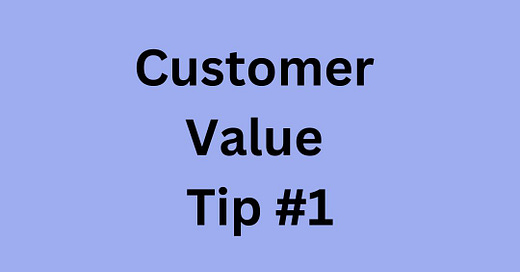Customer Value Tip #1: Lean Into Momentum
How to increase customer value, engagement and retention - one idea at the time.
This is the first post in a new category which I will call “Customer Value Tips”.
I will be sharing quick tips in these posts and focus on ONE idea per post that can be digested in just a few minutes to give you a simple and actionable way to increase customer value.
Let’s jump right in.
A good place to start to increase customer value is to double-down on where there is already a bit of traction. In other words, you want to be looking for a customer behaviour or an activity that is showing some positive signs and results (but not zero, nor already mastered to perfection).
This is essentially your “proof of concept” that things are on the right track and an indication of likely further upside.
To understand why I suggest this, try to visualise a heavy object that is at a standstill and how much force and effort would be needed to put it in motion. Compare this to the same object which is already in motion and already has some momentum.
Applying the same force will make the object accelerate and go further. Even when you let go, the object might even be difficult to stop because it has strong momentum and just keeps going (depending on friction etc). This is Newton’s law of motion in action.
In business speak, this translates into the complexity of projects, resources, time and budget required etc. Basically, everything that you need and think of to get an activity underway with the hope of making a positive impact on the customer.
What might this “momentum” look like in practice when it comes to customer behaviours and segmentation?
For illustration purposes, consider the example of a health & fitness club, where a simplified customer segmentation model consists of:
couch potatoes
new-joiners
gym rats
It would be a difficult sell to convince someone with a sedentary lifestyle to suddenly become an active gym-goer, but there would be plenty of upside if it did happen. In contrast, it would be quite an easy sell to convince a gym rat to go even more often, but perhaps with limited upside for the club as these guys and girls are already daily visitors and at the top of their game.
If we are looking for ONE simple and actionable idea that is more likely to get good traction and add value it would be to focus on the new-joiners in this case. Here we have some of the positive customers behaviours we want to see and there is also plenty of upside.
To continue with our Physics analogy, now think about this concept slightly broader not just in terms of activity (i.e. “velocity”) but also in terms of customer volume/scale (i.e. “mass”).
Here is a practical example. Let’s assume that there are 100 new joiners at a given moment in time. Without any external influence, the behaviours and outcomes of these customers fall into three groups:
Group 1: 50 customers - visit once per week
Group 2: 35 customers - visit twice per week
Group 3: 15 customers - visit three times per week
Where do you have most velocity (read: frequency of visits per customer)? — Group 3.
Where do you have most mass (read: customer volume)? — Group 1.
Where do you have the most momentum? — Group 2 (Velocity x Mass)
To keep this simple and give you ONE idea to work with to drive customer value, look for any combination of both activity and scale to identify where there is most momentum and find ways to lean into that force.
In reality, things are a lot more complex than this and we should ideally be approaching this holistically with tailored marketing and customer engagement plans for all the above segments and then cater to the specific customer behaviours and circumstances in each, and we can go into these bits in more depth in future posts.
If you enjoyed this article, please give it a like or a share it with a colleague. If you have any questions or comments, I’d love to hear what’s on your mind. Feel free to get in touch!


